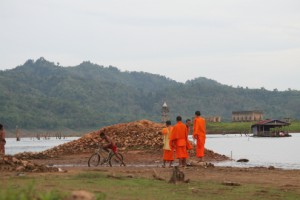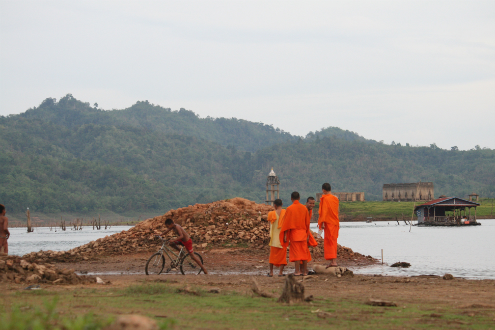By LAWI WENG – At the old Three Pagodas Pass, a Mon temple has emerged above the surface of the lake near Sangkhlaburi as its water has been at an all-time low. As a result, bicycles, motorbikes and cars are now able to drive to the pagodas.

The pagodas and the temple flooded 27 years ago during the construction of a hydropower dam in Thong Pha Phum, which damaged sights; including many small pagodas, Buddhist statues, and houses of Mon and Karen villagers staying near the lake.
Nai Chit Ngwe, an owner of 10 houseboats in the lake mentioned: “The deepest point of the lake is usually 70 feet, though now it is only 10 feet”.
What used to be a lake now seems a river. This body has been a source of water for Sangkhlaburi’s households and its fish have been a source income.
“If the water keeps going down like this, we will have a huge problem.” says Nai Chit Ngwe.
There are some areas of the lake that boats cannot ride anymore. The lake’s houseboats have limited space on the water as the water level has been falling.
Mon Buddhist monks, children, Thai visitors, and foreigners visit the site of pagodas every day, especially, during the weekend.
The lake becomes a picture scenery, which has a wide array of colors during evening time including green grass, big branched trees, house boats, and people growing vegetables and flowers on land formerly being covered by the lake. There are also people playing cane ball, and children playing football.
For many years, people could not see Three Pagodas Pass while it was flooded. However, the pagodas did appear once last year during summer.
Nai Sunthorn, a community leader in Sangkhlaburi, said, “There is a historical meaning of this Three Pagodas Pass, mentioning ‘Buddha, Dhamma, Sankha’.
The pagodas are badly damaged, and parts are just broken bricks. Visitors have paid respect by burning candles.
Before the dam was established, Mon, Karen, and Thai people stayed at one side of the lake together. However, today, Thailand’s longest wooden bridge separates the Karen and Thais living one side of the lake, and Mon living on the other.
There are an estimated 10,000 people at the Mon culture village. Many people are Mon. Rev. Uttama established the culture village in 1984.
Rev. Uttama migrated to Thailand in 1949 with 60 followers, trying to avoid the civil war in Burma. He passed away on October 18, 2006. Rev. Uttama had a strong spiritual influence on the Mon, Karen and Thai, and helped establish Three Pagodas Pass, Sangkhlaburi, Thong Pha Phum and Tha Thoung Nar.
Now, life of the people on Sangkhlaburi’s Mon Side is different than in the past. Many of them got Thai identity before Rev.Uttama passed away, which allows them to work and travel freely in Thailand.
In the past, the Thai government did not allow Mon people to have Thai identity; despite these people having lived here for several decades. Before people were isolated in their village, not being allowed to travel and work.
After people got Thai identity, many of them have set up stores and market stalls selling commodities in the village. Some people built new houses, and contributed to the development of town.
In the past, people did not dare to build nice houses as they were worried about being forced to leave Thailand, needing to abandon their properties when they would go back to Burma.
A new young Mon Abbot “Mahasuchat” currently leads the village. He often reminds the Mon to be peaceful and united.
Many people who stay at the village are shopkeepers. Due to a large number of visitors, the village its market is the main source of income.
Shopkeepers from the village buy Burmese furniture and food from the Burmese side of Three Pagodas Pass, which is about a 45 minutes drive by motorbike. As the price of Burmese food and furniture are cheaper there, people export good form Burma to sell things in Sangkhlaburi, allowing them to earn some profit from visitors buying these things.
“The Mon people were like chicken in the past, which often had to run while the Thai police came to arrest them. Now they do not have to run anymore,” said Nai Ork Pung, a well-respected Mon cultural specialist living in Sangkhlaburi.
Sangkhlaburi town is well known as a haven of freedom for the Mon community. Thai school authorities allow students to wear traditional Mon dress every Friday.
Nai Ork Pung said that he does not like to settle in yet another country, as he knows the situation will differ from Sangkhlaburi’s. “I do not want to go away from the village. I feel this is my hometown and I am at peace here,” he said.
Many Mon people would agree with Nai Ork Pung, especially Mon who resettled in foreign countries. Some Mon people, who now live outside of Thailand, have now built luxurious houses in Sangkhlaburi.
Mon people who settled outside of this area have said that Sangkhlaburi is a town where they are free to engage in politics and Mon affairs freely and would like to come back one day.
The land controlled by U Uttama is not for sale and anyone who wants can build a house on it. However, there are many people selling land, which is in high demand, thus very pricy.
The village has a Mon TV channel, which shows Mon culture, dance, opera, Mon festivals, and bull fighting from Mon State. A Mon man, “Nai Lawi Chan”, runs the TV channel.
Many children rely on Mon as their mother tongue, but perceive themselves as Thai rather than Mon nationals as they have Thai identity.

